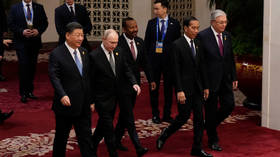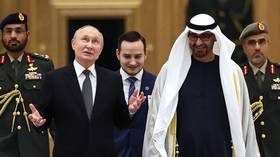As the new international order takes hold, what can we expect from China and the rest of Asia in 2024?

The formation of a new international order is inevitably accompanied by a conflict between the powers seeking to preserve their status and rivals whose development determines the creation of new rules and customs of interaction on the world stage. The military and political conflict between Russia and the West, as well as the gradually accelerating confrontation between China and the US, determine the central position of Greater Eurasia and Asia in international politics. This is, first and foremost, because this vast region is a space where stability and development are important for Moscow and Beijing, while crises and conflicts are highly desirable for the United States and its European satellites. The year 2023 has shown that Greater Eurasia and Asia have so far been resistant to the negative external influences that are having the most dramatic consequences in Europe and Middle East.
The fact that there are no opposing military and political alliances in Asia and Eurasia, and that the so-called geopolitical fault lines exist only in the imagination of particularly impressionable readers of American newspapers, is due to the peculiarities of this space’s political culture, but also to the general trends of international life at the present time.
Firstly, although this macro-region has its own experience of resolving interstate contradictions, conflict as the best way to achieve goals is not a central part of its foreign policy culture. In other words, where Western nations like to take up arms and see the solution to complex situations in confrontation, Asia and Eurasia prefer to resolve disputes peacefully.
Secondly, the emerging associations of states in Asia and Eurasia are not aimed at achieving aggressive goals against third countries. They are primarily aimed at achieving their members’ development goals and maintaining their internal stability. Therefore, there are no alliances in Asia and Eurasia that are created to ensure the privileged position of their members vis-à-vis the rest of the macro-region.
Thirdly, there are no relatively large states within the macro-region that would act as “agents” of extra-regional actors. The only countries that might be exceptions in this sense are Japan and South Korea.
It is true that they have limited sovereignty and are dependent on the US for their basic security. But even in the case of Japan, achieving its development goals and acquiring the necessary resources is not absolutely dependent on an aggressive policy towards its neighbors. This is unlike the European Union, whose leading powers were interested in cornering Russia and gaining monopoly access to its resources. Finally, the comparative resilience of Asia and Eurasia to the challenges of destabilizing interstate relations is due to the fact that all the countries of the macro-region belong to the global majority, i.e. they share common strategic goals, even if the specific tasks required to achieve them may differ.
In other words, if we divide the international community into two groups of countries – those that parasite on the rest and those that rely on their own resources (natural or demographic) – we will not see representatives of the first group in Asia and Eurasia. This makes their interests common, even if their methods of achieving their goals may be different.
At the same time, as the major events of regional life in 2023 have shown, Asia and Eurasia are not free of certain internal contradictions, the resolution of which is an important task for interstate cooperation. Among these contradictions, the relatively difficult relations between the world’s two demographic giants – India and China – are at the top of the list. Despite the fact that New Delhi and Beijing are highly capable of not taking their conflict to the stage of systemic confrontation, the existence of a border problem plays a significant role in regional cooperation in general.
It can be assumed that a minor territorial conflict is a way for both great powers to keep the confrontation space relatively narrow, without leading them to military preparations and a truly large-scale confrontation. At the same time, India’s objective search for a way to increase its joint force capabilities is conducive to its positive dialogue with the US and the West. This, of course, worries Russia and China somewhat, but it has not become an obstacle to cooperation within the BRICS and the Shanghai Cooperation Organization (SCO). Moreover, the accession of India and Pakistan to the SCO has led to a more balanced internal structure of the association against the backdrop of continued rapprochement between Moscow and Beijing.
The Asian part of the macro-region is negatively affected by the growing confrontation between China and the US. Under these circumstances, some Asian states may indeed be concerned that Beijing sees them as the territorial base of its main global adversary or as a source of its own capabilities. This is already leading to complex internal processes in such successful associations as ASEAN, as well as creating interest in some countries to intensify cooperation with the US, as the Philippines is doing, for example. At the same time, we see that Asian countries are tending to raise the bar of their demands in their dialogue with Washington, which is experiencing a new bout of “pact-o-mania”. But they do not want to become satellites of the US or its new “unsinkable aircraft carriers.” The only exception is the island of Taiwan, where nationalist sentiments are a pillar for maintaining the American presence and blackmailing mainland China.
It is necessary to mention the continuing threat of destabilization of such an important part of Eurasia as Central Asia, which consists of the five former Soviet republics and neighboring Afghanistan. There are serious reasons to believe that this area will be used by Russia’s and China’s adversaries to create additional security problems for them. So far, with the exception of Kazakhstan, all the Central Asian countries have demonstrated the ability of their national authorities to deal confidently with the problems that have arisen in the course of their political and economic development. In the case of Kazakhstan, the events of January 2022 showed how fragile its statehood is and how easily it can be threatened by structural problems of an economic and political nature. Uzbekistan, Tajikistan, and Kyrgyzstan, on the other hand, demonstrate either a confident statehood or a consistent move towards being less vulnerable to external challenges and threats.
Some aspects of the future of Asia and Eurasia’s major international institutions are uncertain. We know that the current institutions of international cooperation in Asia and Eurasia were created within the framework of an international order that is now changing and is becoming, in many of its dimensions, a legacy of history. The same is true of the major conflicts in which regional powers are engaged in a colossal space whose main characteristic is the absence of clear dividing lines. However, the institutions in Eurasia may also prove more immune to the systemic problems that this form of state-to-state relations faces against the backdrop of a significant decline in the West’s organizational capacity and its shift towards a purely selfish model of behavior in international affairs.
It is telling that ASEAN, which was created within the framework of the liberal world order and historically aimed to reproduce its basic algorithms for the development of international institutions in local conditions, is currently experiencing the greatest political difficulties.
To sum up the events of 2023, Asia and Eurasia remain a space of cooperation, not competition, and the leading regional powers are able to reach terms that would be relatively fair to their smaller partners. At the same time, all the acute problems facing the macro-region involve an extra-regional player as one of the actors. Localizing the negative consequences of this will be the main task of international cooperation in Asia and Eurasia in the coming years.
This article was first published by Valdai Discussion Club, translated and edited by the RT team.















